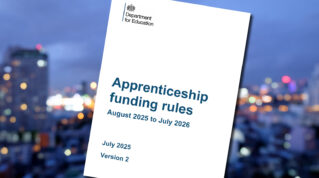Three in ten training providers will flag as “at risk” as new figures reveal tumbling apprenticeship achievement rates.
Combined with 25 per cent falling in the “needs improvement” category of the government’s apprenticeship accountability framework, 54 per cent of training providers fall in scope for some form of intervention.
This has prompted calls from the Association of Employment and Learning Providers, which represents apprenticeship training providers, to call for an “overhaul” of the “out of date” achievement rate model of measuring apprenticeship quality.
Overall apprenticeship achievement rates dropped last year, new figures reveal, leaving the sector even further away from the government’s 67 per cent target.
National statistics for 2021/22 show that the overall achievement rate for apprenticeships fell to 53.4 per cent, a drop of 4.3 percentage points on the year before and eleven percentage points lower than pre-Covid levels in 2018/19.
There were 263,550 leavers in 2021/22, which is just under 12,000 below 2020/21. Of those, 85 per cent were training towards apprenticeship standards. Only 39,450 apprentice leavers were on frameworks, which are being phased out.
The achievement rate for standards in 2021/22 was 51.4 per cent, down 0.4 percentage points on the year before, and for frameworks the rate was 64.9 per cent, down 4 percentage points.
Skills minister Robert Halfon, in a letter to the apprenticeships sector, said: “I know that there is much more for us to do collectively to raise the annual apprenticeship achievement rate, currently standing at 51 per cent for apprenticeship standards.
“While not all the reasons for non-achievement are within the gift of providers or employers, I know that, like me, you want to see this figure improve.”
The letter stated a range of government initiatives aimed at improving quality, including the ETF workforce development programme and the Institute for Apprenticeships and Technical Education’s consultation on mandatory qualifications and end point assessments.
Provider data
This is the first time data on individual providers has been published since 2018/19. Ministers cancelled the publication of provider level performance data for 2019/20 and 2020/21 due to the impact of the Covid 19 pandemic and lockdown measures.
Under the government’s apprenticeship accountability framework, training providers are considered “at risk” if their overall apprenticeship achievement rate is less than 50 per cent and “needs improvement” if it is between 50 per cent and 60 per cent.
Achievement rates are one of a number of measures used by the Department for Education to hold apprenticeship training providers to account.
Today’s data shows that 309 training providers, 29 per cent of the total, flag as “at risk” and 267 (25 per cent) as “needs improvement”. This means, combined, over half of all apprenticeship training providers, 54 per cent, could be in line for “management conversations” with DfE managers and enhanced performance monitoring.
According to the statistics, 85,250 apprentices trained with providers that scored an overall achievement rate of below 50 per cent, which represents around a third of the total.
And 789 providers, three quarters, are currently below the government’s target of 67 per cent by 2025.
Skills minister Robert Halfon recently confirmed to FE Week that the 67 per cent achievement rate target introduced by one of his predecessors, Alex Burghart, was still in place and that he is “working very hard to try and improve that”.
Providers in scope for additional monitoring can face new contract conditions, restrictions on subcontracting and, ultimately, contract termination.
Training body wants change
Training provider body AELP has said measuring apprenticeship quality using achievement rates is no longer fit for purpose.
It pointed out that the reduced overall achievement rate reflects “the residual impact of the Covid 19 pandemic” on the labour market, and said the “methodology still counts learners who left years ago based on their planned end dates alongside the impact breaks-in-learning has had.”
Chief executive Jane Hickie said: “The way in which apprenticeship achievement rates are calculated is out of date, and represents a regime prior to the introduction of an employer led system.
“We should be far more focused on outcomes, not outputs, including for those who don’t complete their apprenticeship.”
Hickie suggests “tracking learner progression and earnings following an apprenticeship” as a more effective measure of apprenticeship quality.

















My goodness, how many times do we have to say “QAR and QRR are only two of a basket of measures”? There’s clearly no way ESFA can put a third of their providers under any sort of meaningful additional monitoring, there just aren’t enough bodies in the Agency to get anywhere close to it. And they’ve been *exceptionally* clear (and, by gum, it’s not often I say that) that the Accountability Framework is the start of a conversation, not a sledgehammer fixed set of responses… Reporting like this is just scaremongering…
Scaremongering that also lacks insight.
The decreasing cohort size on frameworks is very significant and we know that comparing frameworks to standard is apples and oranges, but this is largely overlooked in the pursuit of attention grabbing headlines.
The real missing link is the lack of publicly available benchmarking data relating to past end dates and how successfully they are being converted across occupations and the provider base. When there are no ‘natural’ withdrawals left in an annual cohort, (ie withdrawals before planned end), it does funny things to achievement rates…
Also, PEDs play a part in achievement rates for standards. The ‘true’ achievement rate on a standard can be delayed in the early years of its life as some achievement is displaced into a future QAR year.
There are things other than quality at play here, but fear and ignorance sells webinars!
Will FE week be reporting on the wide and enduring achievement gaps along ethnicity and disadvantage lines?
Its just completley unrealistic! We are still feeling the effects of coming out of the pandemic! And as much as the “employers grant” increased starts! It also had a detrimental effect on ITPs with some employers rushing to take apprentices on! Which had an impact further down the line!
It would also be good to break it down by standard’s, we have a 92% success rate with our Lab Science, Engineering and Data programmes. Sector break down is also important but analysis of the dat is always based on grabbing headline.
Totally agree, you can have a very successful sector and high success rates. But through circumstances another area can pull that over all figure right down.
Its also about the numbers , if you have 1 learner leave and they are successful – 100% if that one learner didn’t achieve its 0%. When you are looking at very small samples it gives the wrong impression. There are always mitigating circumstances too, but no one is interested in that side of things.
You need to be explaining success rates in your SAR and what you did to try and keep them up, taking into account your local and national circumstances. The ESFA have not got sufficient understanding to look at what you offer and what impacted on your apprentices and employers, so do it for them. They are supposed to check your SAR for explanations so give it to them.
Data includes those who withdrew in the first 6 weeks of the program and should not. New providers and or those with a small learner base are adversely impacted. The calculations of withdrawals in different years and what year they impact the QAR QRR is nonsense. Bears no relation to the issues with the employer eg, they have gone bust or made redundancies.
Etc Etc Etc
The accountability framework appears to have no relation to most providers’ environments. I wonder who is actually accountable for this total nonsense?